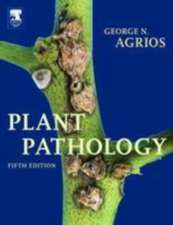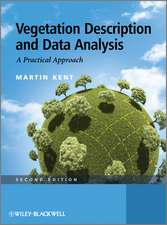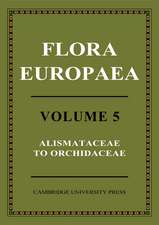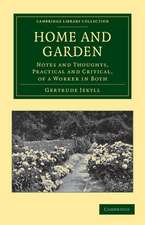The Role of Plant Pathology in Food Safety and Food Security: Plant Pathology in the 21st Century, cartea 3
Editat de R.N. Strange, Maria Lodovica Gullinoen Limba Engleză Paperback – 4 mai 2012
| Toate formatele și edițiile | Preț | Express |
|---|---|---|
| Paperback (1) | 938.34 lei 6-8 săpt. | |
| SPRINGER NETHERLANDS – 4 mai 2012 | 938.34 lei 6-8 săpt. | |
| Hardback (1) | 942.63 lei 6-8 săpt. | |
| SPRINGER NETHERLANDS – 16 dec 2009 | 942.63 lei 6-8 săpt. |
Preț: 938.34 lei
Preț vechi: 1144.32 lei
-18% Nou
Puncte Express: 1408
Preț estimativ în valută:
179.61€ • 195.16$ • 150.97£
179.61€ • 195.16$ • 150.97£
Carte tipărită la comandă
Livrare economică 21 aprilie-05 mai
Preluare comenzi: 021 569.72.76
Specificații
ISBN-13: 9789400731080
ISBN-10: 9400731086
Pagini: 164
Ilustrații: VIII, 155 p.
Dimensiuni: 155 x 235 x 9 mm
Greutate: 0.24 kg
Ediția:2010
Editura: SPRINGER NETHERLANDS
Colecția Springer
Seria Plant Pathology in the 21st Century
Locul publicării:Dordrecht, Netherlands
ISBN-10: 9400731086
Pagini: 164
Ilustrații: VIII, 155 p.
Dimensiuni: 155 x 235 x 9 mm
Greutate: 0.24 kg
Ediția:2010
Editura: SPRINGER NETHERLANDS
Colecția Springer
Seria Plant Pathology in the 21st Century
Locul publicării:Dordrecht, Netherlands
Public țintă
ResearchCuprins
The Role of Plant Pathology in Food Safety and Food Security.- Plant Diseases and the World’s Dependence on Rice.- Development of Appropriate Strategies to Control Cassava Diseases in Ghana.- Biosecurity in the Movement of Commodities as a Component of Global Food Security.- Global Food Security.- ISPP and the Challenge of Food Security.- Globalisation and the Threat to Biosecurity.- Genetic Modification (GM) as a New Tool in the Resistance Toolbox.- The Role of Plant Pathology and Biotechnology in Food Security in Africa.- Mycotoxins.- The Secondary Metabolite Toxin, Sirodesmin PL, and Its Role in Virulence of the Blackleg Fungus.- Biological and Chemical Complexity of Fusarium proliferatum.- Biosecurity and Quarantine.- Bioterrorism: A Threat to Plant Biosecurity?.- The Revised International Plant Protection Convention – a New Context for Plant Quarantine.- Pest Risk Analysis as Applied to Plant Pathogens.
Recenzii
From the reviews:
“This is again a slender volume, with only 12 papers, but represents a rapidly expanding area of plant pathology. … They bring together a summary of work across the whole field of plant pathology … . They thus enable specialists to see their specialism as part of an integrated whole, and for students and those at the start of their careers they provide an invaluable summary of what is going on, who the key players are and where the knowledge lacunae lie.” (David Ingram, Food Security, Vol. 3, 2011)
“This is again a slender volume, with only 12 papers, but represents a rapidly expanding area of plant pathology. … They bring together a summary of work across the whole field of plant pathology … . They thus enable specialists to see their specialism as part of an integrated whole, and for students and those at the start of their careers they provide an invaluable summary of what is going on, who the key players are and where the knowledge lacunae lie.” (David Ingram, Food Security, Vol. 3, 2011)
Notă biografică
Richard N. Strange is Senior Lecturer in Plant Pathology at University College London and has a special interest in the plant disease problems of developing countries. Maria Lodovica Gullino is a professor of plant pathology at the University of Torino and President of the International Society for Plant Pathology. She has long term experience in plant disease management.
Textul de pe ultima copertă
This book views the vulnerability of our crops in general to devastating diseases as well as specifically the disease problems of two important staples, rice and cassava. Increased travel and increased transport of plant material throughout the world pose ever more significant risks to the health of our plants. These include not only the destruction of our food crops by pathogens which may be imported accidentally or maliciously but also their contamination by fungi that produce powerful toxins (mycotoxins). How we should respond to these challenges is the subject of several papers. Clearly, quarantine is an important measure by which the spread of plant pathogens may be at least delayed, if not curtailed altogether, but breeding plants for resistance is the mainstay for maintaining the comparative health and productivity of our crops. However, adequate resistance may not be available in the gene pool of a given species or genus and therefore the possibility of genetic modification arises, a topic treated in two of the papers.
Caracteristici
Stresses the importance of plant disease as a drain on food supplies


















